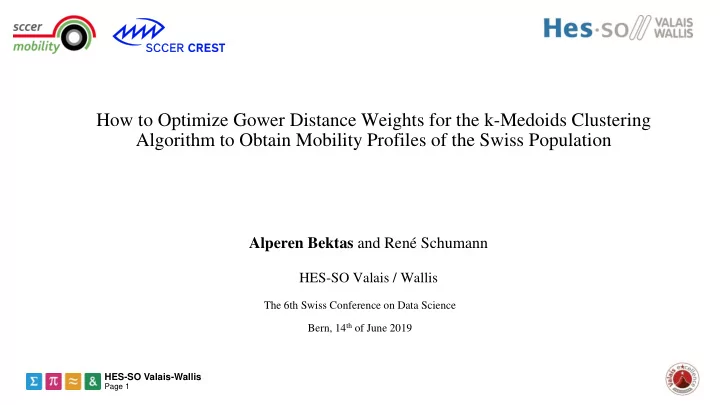

How to Optimize Gower Distance Weights for the k-Medoids Clustering Algorithm to Obtain Mobility Profiles of the Swiss Population Alperen Bektas and René Schumann HES-SO Valais / Wallis The 6th Swiss Conference on Data Science Bern, 14 th of June 2019 HES-SO Valais-Wallis Page 1
Content ➢ Introduction ➢ Data Source / Variables ➢ Generating Multidimensional Social Space (Latent Space) ➢ Clustering Algorithm ➢ Average Silhouette Width (ASW) ➢ Optimization ➢ Overall Concept ➢ Results ➢ Limitations / Future Work HES-SO Valais-Wallis Page 2
Introduction ➢ The goal: Obtaining mobility profiles of the Swiss population ➢ Respondents of empirical data (Census) ➢ Mobility-related features of the respondents are ex-ante selected ➢ Clustering as methodology ➢ Respondents who have similar mobility characteristics are placed in the same cluster ➢ Why not having better clusters? Can we improve quality? ➢ Higher inter-cluster heterogeneity (separation) ➢ Lower intra-cluster homogeneity (cohesion/similarity) HES-SO Valais-Wallis Page 3
Empirical Data Mobility and Transport Micro-Census 2015 ➢ Ex-ante feature selection (active/descriptive) ➢ Mobility-related features are chosen ➢ Eliminating some active features ➢ Remove highly correlated variables (measure the same ➢ thing) Remove categorical variables in which a category is ➢ very dominant Remove categorical features with too many levels ➢ HES-SO Valais-Wallis Page 4
Empirical Data 6 active variables are used to determine positions in the latent space ➢ ➢ Number of cars (in the household) ➢ Has half-fare travel card (binary) ➢ Number of daily trips ➢ Daily distance (kilometers) ➢ Modal-choice (car, train, walking, etc.) ➢ Multi-modality (binary) Active variables are mixed-type (numeric/categorical) ➢ HES-SO Valais-Wallis Page 5
Multi Dimensional Social Space Respondents are placed in a Latent Space ➢ Distance (Dissimilarity) Matrix functions as the latent space ➢ Various metrics can handle it e.g. Euclidean ➢ Gower distance metric ➢ Can handle mixed-type data sets ➢ All variable has a weight (default all equals 1) ➢ Weights can be tuned ➢ Distances are normalized between 0-1 ➢ Peer-wise distances (symmetric) determine the closeness ➢ According to the positions in this space, a clustering algorithm partitions them ➢ HES-SO Valais-Wallis Page 6
k-Medoids (partitioning around medoids, PAM) Unsupervised partitioning algorithm ➢ Robust to outliers ➢ Finds a medoid (exemplar, representative) of each cluster ➢ Gets a latent space (distance matrix) and the number of ➢ clusters (k) as input Based on positions in the space, respondents are partitioned ➢ into k clusters In the end, clusters, intra-cluster distributions, and medoids ➢ are obtained HES-SO Valais-Wallis Page 7
Average Silhouette Width (ASW) ➢ The number of clusters (k) should be pre specified ➢ How well an instance is matched with its own cluster ➢ A fitness measure that reflects how maximized intra- cluster homogeneity and inter-cluster dissimilarity ➢ K-value that has the highest ASW score is assigned as the optimal number of cluster HES-SO Valais-Wallis Page 8
Optimization ➢ Tune default Gower weights ➢ Optim function in R language ➢ Function B minimizes the return of Function A ➢ Best weight combination that maximizes the ASW value of k clusters is obtained HES-SO Valais-Wallis Page 9
Overall Concept 1 st step: the optimal number ➢ of clusters is obtained 2 nd step: The ASW value of ➢ the optimal number of clusters (obtained in the first step) is improved through optimizing the default Gower weights. HES-SO Valais-Wallis Page 10
Results-(1 st step) The optimal number ➢ of clusters: 13 (ASW=0.7465) The second best: 12 ➢ (ASW=0.7300) Interval [2-15] ➢ HES-SO Valais-Wallis Page 11
Features Optimized Weights Results-(2 nd step) Number of cars 1,000000 Has half-fare travel card 2,469693 Optimized Gower ➢ Weights New ASW value of 13 ➢ Daily trips 1,000000 clusters 0.8458 (ex - 0.7465) Daily distance 1,000000 New ASW value of the ➢ control 0.8349 (ex – 0,7300) Modal Choice 3,000000 Multimodality 2,640402 HES-SO Valais-Wallis Page 12
Results-(Clusters and Medoids) Private car: 4, 11, 8, 2 ➢ Walker: 1, 10 ➢ Train: 5, 2 ➢ Bike / E-bike : 12, 7 ➢ Bus: 9, 6 ➢ Tram: 3 ➢ HES-SO Valais-Wallis Page 13
Limitations / Future Work ➢ Interval of k-values [2-15] ➢ Upper bound of the weights ➢ Challenging limitations ➢ Synthetic population generation ➢ Policy extractions (messages) over medoids / profiles HES-SO Valais-Wallis Page 14
Questions HES-SO Valais-Wallis Page 15
Recommend
More recommend